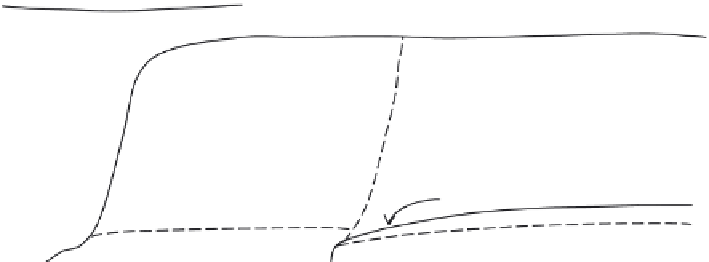Geoscience Reference
In-Depth Information
z
“Free” atmosphere
Capping inversion layer
Outer region
or
mixed layer
Residual
mixed layer
Stable boundary layer
Unstable ASL
Stable ASL
0600
1200
1800
0000
0600
Sunrise
Sunset
Fig. 2.7
Sketch of the typical diurnal evolution of a fair weather atmospheric boundary layer (ABL) over land
under clear sky around the time of the equinox. The inner region or atmospheric surface layer (ASL)
is unstable during the daytime as a result of solar heating at the surface; the ASL is stable at night as a
result of radiative cooling. During the day the outer region is characterized by convective turbulence,
fed by heating through the surface layer; after sunset this outer layer becomes virtually uncoupled
from the surface, by the development of the stable nocturnal boundary layer.
free stream velocity outside the boundary layer, whereas in the
inner region
, also called
variously
atmospheric surface layer
(or ASL),
Prandtl layer
or
wall layer
, the flow is
more strongly affected by the nature of the surface (see Figure 2.6).
In the atmosphere, under conditions not very different from neutral, the outer region
is affected both by the pressure gradients, reflecting larger scale weather patterns, and
by the Coriolis forces, reflecting the effect of the rotation of the Earth. Under unstable
conditions, the effects of the pressure and Coriolis forces are relatively small, and the
outer region is more characterized by thermal convective turbulence; the outer region
may then be referred to as the
mixed layer
or the
convection layer
. The upper limit
of the unstable boundary layer is typically indicated by a sharp inversion, that is, a
layer of stable air. Over land, the thickness of the boundary layer tends to vary in the
course of the day. Consider for instance a typical evolution at mid-latitudes, in the
absence of rapidly changing weather with passing fronts or precipitation activity. As
stable conditions develop during the night, the boundary layer may range from a few
tens of meters in the evening to about 500 m by early morning; then after sunrise, a new
unstable boundary layer develops which may eventually reach a thickness of 1-2 km
at full maturity by the middle of the day. This evolution is sketched in Figure 2.7.
Figure 2.8 shows an example of the evolution of the temperature profile in the course
of a sunny day. As a rule of thumb, the thickness of a typical boundary layer can be
assumed to be of the order of 1 km; it is usually larger under unstable than under neutral
conditions.
The thickness of the atmospheric surface layer (or ASL) is usually taken as the lower
one tenth of the boundary layer. While there are several ways of defining this thickness








